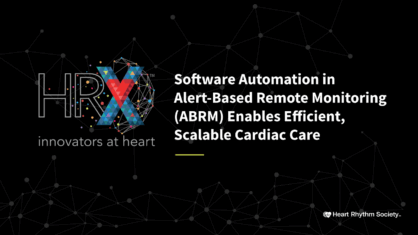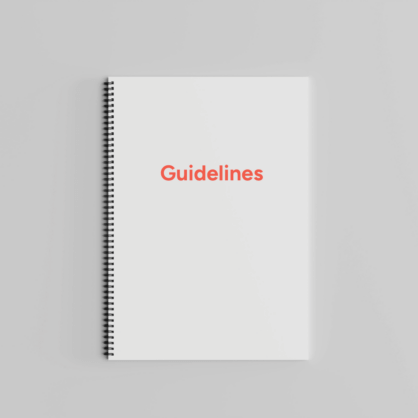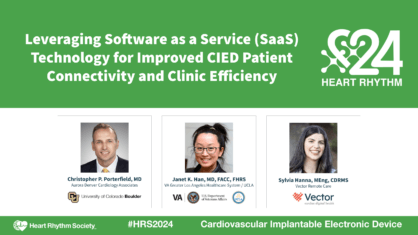How to Incorporate Remote Patient Monitoring Into Existing Workflows

Remote patient monitoring (RPM) is a service under the telemedicine umbrella that uses specialized technology to track patient health data in real time, integrating care updates into clinic workflows as needed.
RPM plays an important role in cardiac clinics. The technology allows clinicians and staff to respond to rhythm changes or more critical alerts as soon as they happen in order to improve outcomes and streamline impactful care.
According to a survey conducted by market research firm MSI International, 4 out of 5 Americans are in favor of remote patient monitoring, with more than half of respondents open to having it incorporated into their personal medical care.
The benefits of the technology are clear. If the only thing stopping you from integrating a remote patient monitoring program into your clinic workflows is not knowing where to start, this post is for you.
Below you’ll find a high-level integration guide featuring questions to ask, training to consider and tips for maintaining program success.
Determine what your goals are
You’re not going to be looking at remote patient monitoring programs unless your clinic needs something they can provide. Common goals for clinics looking to implement RPM into their workflows include:
- Reducing readmission rates
- Improving patient outcomes by promoting adherence to care
- Increasing patient engagement by making it easier to provide them with personalized care
- Enhancing care coordination by simplifying the sharing of patient data and real time care collaboration
- Reducing healthcare costs for both your clinic and patients through lowered rates of readmission and costly complication
When determining what your goals are, it’s good to get buy-in from both clinicians and administrators by keeping communication avenues open. The benefits are undeniable, but part of getting buy-in is helping decision-makers understand them. By talking about RPM openly and sharing clinical research and associated resources, it’ll be a lot easier for everyone to take the next step.
Review your existing workflows
In order to determine the best way to integrate remote patient monitoring into your clinic’s existing workflows, you have to review what you’re doing already. Take a look at what your clinic staff is currently doing and consider the following questions:
- Are there any inefficiencies in your current workflows? Are these workflows aligned with the latest industry standards and regulations?
- Are these workflows aligned with patient expectations?
- How are patients responding to your current care? Have you received any feedback that stands out as repetitive or urgent?
- How is communication between different members of your clinic staff?
- What is working well for you and where would you like to see improvement?
Reviewing what is working — and what isn’t — will make it easier for you to determine what your clinic’s remote patient monitoring program needs are.
Identify which devices you intend to monitor
The right remote patient monitoring solution for your clinic is one that offers easy manufacturer synchronization and universal electronic health record (EHR) integration. You want to be able to connect with and monitor any type of device and transmit that data to any type of EHR.
For cardiac clinics, that typically includes the following types of devices:
- Implantable Cardioverter Defibrillators (ICDs). These devices are implanted under the skin and can monitor the heart’s rhythm, delivering as-needed electrical shocks to correct abnormal heart rhythms.
- Cardiac Resynchronization Therapy (CRT) Devices. Specialized pacemakers used to treat heart failure, monitor heart rhythm and adjust pacing as needed.
- Implantable Loop Recorders (ILRs). These devices are small and are implanted just under the skin. They continuously monitor and transmit data tracking heart rhythm.
- Remote Patient Monitoring (RPM) Devices. This is a catch-all bucket for the wide variety of devices used to remotely monitor heart rhythm, blood pressure, oxygen saturation and other vital signs.
Choose a remote patient monitoring program that best fits your needs
If you’ve taken the time to determine your goals, review existing workflows and identify device needs, then you’re likely ready to choose a a remote patient monitoring program. The right one is going to align with the needs you’ve identified.
That said, we recommend seeking out solutions that also offer the following time-saving benefits:
- Consolidation of all data into a singular patient portal no matter the device or manufacturer
- Normalization of alert data for actionable, standardized and easy-to-understand reporting
- Customized alert prioritization that makes sure your clinic gets the information that’s most important to you first
- Easy integration with electronic health records for seamless data transfer
Train your clinic staff on proper use
There’s no denying that implementing any new workflow is going to impact clinic staff. When choosing the right remote monitoring program for your clinic, make sure to go with a provider that offers demos so you can review with clinicians to verify fit.
Take advantage of any training made available to you in order to keep any integration disruptions to a minimum.
Monitor and evaluate patient success
Monitoring program success is as easy as looking back at the workflow-evaluating questions listed above and revisiting them regularly after implementation. What is working? What isn’t? Think about questions like:
- How much have false alerts decreased?
- Are patients engaged with the remote monitoring process? Has their level of connection with monitoring increased or decreased?
- How are operations doing? Have patient outcomes improved?
- What has the impact on revenue been after implementing remote patient monitoring into your workflows?
Each clinic’s success will be unique depending on their goals, but all clinics can benefit from optimized patient management and care.
Ready to take another step toward implementing a care-expediting, revenue-increasing remote patient monitoring program at your clinic? Take a closer look at The Vector Patient Care Platform or connect with us directly to discuss exactly what you need and how our software can help.














